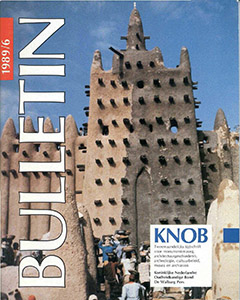Indexering ESCI / Scopus


J.D. van der Waals: Het archeologisch project in de binnendelta van de Niger en het nut van ontwikkelingssamenwerking op sociaalcultureel gebied. C.L. Temminck Groll: Monumentenzorg in Oost en West. Dorothee Gruner: Traditionelle Moscheebauten. Albert van Dantzig: De forten en kastelen van Ghana een collectief monument. Arjen Joustra en Diederik Six: Elmina. Wolf Schijns: Het architectonisch continuüm van Djenné, Mali: opgeven of behouden? Pierre Maas en Geert Mommersteeg: De Moskee van Djenné, morfologie en onderhoud van een Afrikaans monument. Cor Dijkgraaf: Renovaties in de oude stadskern van Sana's, Yemen.
In Europe archeology often has been connected with regionalist or nationalistic interested movements. In some cases archeology thus landed in very risky fairways and in this case it certainly did not promote the development to an independent science with proper theoretical basis. In Africa this is different. Directly after the independence the first president of Mali, Modibo Keita, has sent some promising new-coming students to Europe to study historic sciences, also archeology.
In that new country, of which the borders sometime had been drawn by French offices, tribes lived...
Why talking about Indonesia, Surinam and the Dutch Antilles on a congress clearly dedicated to Africa! This is meaningful, because the subject 'documentation, preservation and restoration of monuments' in the mentioned countries already is historic. Indonesia obtained its Ordinance of Monuments in 1931 (thus actual protection in Indonesia was possible sooner than in Holland itself!). With this the famous Hindu-Buddhistic Antiquities and the Dutch buildings from the East Indian Company-period could be protected
The first already stood outside ordinary life for a long time. Next to...
Architecture stands apart within 'materialized' culture. Until now her socio-historical and ethno-sociological expressiveness - at least for Africa - has been neglected. Between Sahara and tropical rainforest the West-African buildings consist of loam, the oldest and most perishable material on earth. Nowadays this material is disdained and more and more replaced by modern building materials.
The traditional methods are threatened by this, before they even had been recognized as venerable cultural heritage of this area. Between 1976 and 1986 the Frobenius-lnstitut Frankfurt has...
In the colonial history or the history of European expansion like one prefers to call her nowadays the trade forts which have been built in the course of times on Africa's west coast and especially on the Gold coast, play an important role. Ten years before Columbus discovered America the castle Sao Jorge da Mina was built by the Portuguese on a spit of land in Elmina, which already for some time was an important market where merchants from the deep interior exchanged gold and draperies from the Mediterranean area against salt and smoked fish.
Soon it appeared that these African...
Elmina is a West-African town situated at the Gulf of Guinea. Because of her very favourable situation with respect to trade at the end of the 15th century the at that time small fishing-village raised the interest of European powers. These contacts determined the development and in an important measure also the character of the town. The castle Sao Jorge da Mina, which was built by the Portuguese near the village hereby played a central role.
From 1637 to 1872 the castle was Dutch headquarters at the Goldcoast and the village developed into an important commercial town. At the...
With this question attention turns again to the research of possibilities and usefulness to preserve the architecture of the African town Djenné in Mali. Djenné with her rich past certainly is of great socio-historical and architectural importance. Nowadays however the built cultural heritage is posed to fast changes and even is busy to disappear on several vital points. Sahel drynesses, economical recess, a leaving population, changing society and an increasing influence of western consumption-culture can be pointed out as important causes, which unfortunately are not temporary.
...The Mosque of Djenné, Mali, was first founded in the 14th century, destroyed in 1830 during a jihad (holy war) of the orthodox Peul population and rebuilt in 1907. In the city of Djenné the mosque, also called the Great Mosque, takes a dominant place on a higher level at the market place. Though typical and local architecture and materials are used, the mosque is in it origins a traditional and orthodox one with the Gibla-wall, the covered hall for praying in the eastern part of the building and an inner square.
The east-facade, with the outer-side of the Gibla-wall is marked by...
Excavations in Yemen have pointed out that more than 2000 years ago Yemen houses resembled present-day Sana'a dwellings. At Shabwa French archeologists discovered multi-floors, high palaces and dwellings consisting of more than 8 layers from the 3d century before Christ. Azal or Uzal is the old name for Sana'a and is mentioned in the book Genesis of the Old Testament. Of course one cannot determine whether Uzal really has founded the town Sana'a. On the other hand Sana'a is one of Arabia's oldest towns.
Until now no archeological research has been executed within the walls of the...


open access mogelijk gemaakt door Stichting OpenAccess
